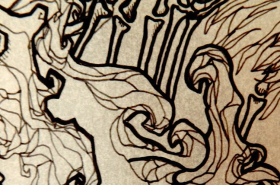Fight scenes. Whether live action or written, they can be such a pain to pull off, falling all too easily into the realm of cheesy. You know the ones I mean; we’ve all seen and read them– fight scenes where the creator was more focused on what looks cool and/or badass, and less so on believability.
Recently, I sent a frustrated plea to the Twitterverse, begging authors to do their research before including the martial arts in their fights. Believe it or not, it wasn’t until after I sent that plea that the light bulb appeared and I realized I’m in a unique position to help my fellow authors. As both a martial artist and a writer, I have insight that could help authors overcome the hurdle of fight scenes. So today, I’m going to use that background to dissect a written fight scene and hopefully illustrate how to effectively incorporate martial arts techniques. About time, right?
First, let’s take a look at what you don’t want to do.
_________
Charlie grunted as his back slammed into the wall, his opponent’s hands wrapped thoroughly around his throat. He struggled, trying to kick his opponent in the groin but only managing to connect with the man’s shin. The attacker snarled, loosening his hold on Charlie’s neck. Without pausing, Charlie threw his left arm between them, turning to the side and trapping the attacker’s arm against his own chest before elbowing the man in the face.
The attacker stumbled backwards, grasping at his bleeding nose. Charlie didn’t wait. He had the upper-hand. He advanced toward his opponent, his hands raised to guard his face, his body relaxed into a sparring stance. The attacker glared up at him, straightening into a matching stance.
With a yell, Charlie threw a round-kick at the attacker’s head. His opponent ducked, sliding between Charlie’s legs on his knees and jumping to his feet with a swift kick to Charlie’s back. Charlie stumbled forward, turning to face his attacker before he was struck again and instantly ducked the knife hand strike aimed at his head. Charlie responded with a flurry of punches, varying his target from the man’s head to his torso and back again. The man blocked most, but a few landed, knocking the attacker from his feet.
Charlie stood over him for a split second before finishing him off with a well-placed axe kick to the sternum. As the attacker rolled on the ground, sputtering, Charlie ran for the safety of a nearby cafe.
_________
Now, that’s shockingly not as bad as some I’ve seen, although it’s sure not going to win me a Pulitzer either. Some of you may even think this is an alright fight scene, aside from the obvious grammatical flaws that could be fixed with a few more drafts. But this is the example of what not to do, remember? So let’s figure out why.
Did you notice that I gave you very little about why this fight is happening, or where? I didn’t even give you the attacker’s name! But I did tell you in agonizing detail the techniques they’re using and where the blows land, placing all the emphasis on the choreography, and none at all on the characters or motivation behind this moment. The result? A laundry list of steps you could re-enact, but that you feel not at all.
That’s because this approach is all telling. That’s right, the infamous telling vs. showing debate. I tell you exactly what’s happening, but I don’t show it at all. You don’t feel invested in Charlie’s situation. You don’t feel the emotions. You feel excited, sure, because it’s action, and even poorly written action is exciting. But it has no lasting impact on you, does it? This scene is about as forgettable as they come.
It’s also unrealistic. Who out there noticed the completely implausible choreography I threw in? I know the martial artists in the audience did, because it screams “cool factor,” it’s entire existence a nod to something awesome and badass, but that in reality is actually physically impossible.
If you guessed the knee slide under Charlie’s legs, you’d be correct. Bravo! You get a cookie.
This is why it’s important to understand the dynamics of a fight, not just the choreography. Those who have done a round kick know that while performing it, you balance on one leg, your body positioned so that your center of gravity is entirely over that back leg. If someone were to try and go through your legs the way I described, they would take out your supporting leg and you’d both end up in a flailing pile of limbs.
And then there’s the knee slide itself. If you read it closely, you realized the attacker is standing still. Where’d he get the momentum for a knee slide? Unless they’re fighting on a slick, hardwood floor that’s just been mopped, he would need a running start. I don’t know about you, but if I tried to drop to my knees to slide anywhere, I’d be sitting on the floor looking like an idiot asking to get kicked in the face. It’s just not believable.
So let’s try that scene again, this time, fixing all those things I called out.
_________
Charlie grunted as his back slammed into the wall, Eric’s hands wrapped around his throat. Hate emanated from his friend’s eyes, judgement and accusation burning them into a sinister shade of blue. Charlie gasped, choking as Eric’s fingers cut off his air like a tourniquet.
His mind screamed at him, desperate to know why it was being punished. His lungs burned, his mouth working like a fish on dry land, sucking in nothing but fear. The edges of his vision started to grow fuzzy, black dots appearing over Eric’s shoulder, distorting the red glow of the club’s EXIT sign like reverse chickenpox. Panic flooded his veins with adrenaline. He struggled, clawing at the fingers sealed around his throat. He tried to kick Eric in the groin but only managed to connect with his shin, the impact ricocheting painfully through his foot.
Eric snarled, loosening his hold, giving Charlie the opening he needed. He threw his left arm between them, turning to the side and trapping Eric’s arm against his own chest before elbowing his best friend in the face.
Eric stumbled backward, grasping at his bleeding nose. Charlie didn’t wait. He advanced toward his opponent, his hands raised to guard his face, his body relaxing into the sparring stance he’d practiced for years– knees bent, weight forward on the balls of his feet, head lowered. Eric glared up at him, straightening into a matching stance. Their eyes locked. It was just like old times, only now there was no one to referee the match, to stop it before it went too far.
All this for a girl. Charlie knew it was ridiculous, that he should walk away, but fury mixed with adrenaline, coursing through him like a pulsing heat. If Eric wanted a fight, that’s what he’d get.
With a yell, Charlie threw a kick at Eric’s head. Eric ducked, sliding easily into a leg-sweep, knocking Charlie’s support from under him. The ground smashed into his back, forcing the air from his lungs in a rushing wheeze. He rolled backwards to his feet, still fighting against the tightness in his chest. Eric closed in on him, pushing his advantage, arms and legs flying. Charlie blocked as many of the blows as he could, his arms jarring in their sockets every time he did, his ribs and face blossoming with pain every time he didn’t. He stumbled back through the shadows of the alley until he was once again cornered. Cringing, he held his hands up in surrender. Eric backed off, eying him warily as he spit blood onto the darkened pavement.
Charlie’s knuckles were bleeding, his ribs bruised, and his lip split into an oozing gash. It was time to end this.
“Alright, I give,” he said, the words gravelly and pained as he forced his battered throat to work. “I’ll never go near your sister again.”
_________
Still not the most epic writing sample, but you see the difference, I hope? Now we not only know who Charlie’s fighting, but why. I’ve also fixed the choreography so that it’s believable, and added emotional content and description, putting the focus on the characters instead of the martial arts. No one cares about the techniques, but they care a lot about how those techniques feel, the emotion behind the action. Understanding that is the difference between creating a scene from a clinical distance and creating a deeper POV that will resonate with readers.
So, how can you take your fight scenes from flat to amazing? Easy, just remember these three things:
- Show, don’t tell. The techniques themselves are not important, the emotion is. Only use a technique name if there’s a reason we need to know the exact kick, etc.
- Believability is king. Never throw something in just because it sounds awesome. Make sure it’s actually physically possible and makes sense with the choreography and your world.
- When stumped, ask an expert. If you’re at a loss, find someone familiar with the martial arts and ask. Don’t just rely on Google and Youtube. They won’t give you the insight personal experience can.
That’s really all there is to it. Not so hard after all, is it? And if you ever find yourself in need of some martial arts feedback, I’m always available. Just send me a note at kisa (at) reuts (dot) com with your questions and I’ll happily provide some help. 🙂
**This post has been syndicated from Senior Editor Kisa Whipkey’s personal blog, Nightwolf’s Corner.**



